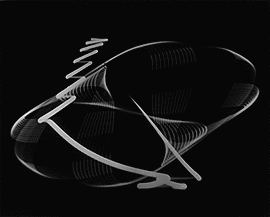Mary Ellen Bute Abstronic (USA, 1954)
 In 1954 Mary Ellen Bute began using oscilloscope patterns to create the abstract forms and figures typical of her films. She claimed to be the first artist capable of combining "art and science" through her so-called Seeing Sound films. Her two most important works (Abstronic first and Mood Contrast later) point out how music's electronic images are natural phenomena happening in the sub-atomic world, captured by a Cathode Ray oscilloscope and filmed with a camera. Although the images captured by Bute's cathode ray tube are all in all simpler and weaker if compared with the same period Norman Mc Laren's (Around is Around) and Hy Hirsch's (Divertissement Rococò), the use of hand-made colourful backgrounds and superimposed to the electronic animations of the musical themes and animations supplements united to some trick, such as diffraction mirrors, make her works full of depth, dynamism and rhythm in relation to music.
In 1954 Mary Ellen Bute began using oscilloscope patterns to create the abstract forms and figures typical of her films. She claimed to be the first artist capable of combining "art and science" through her so-called Seeing Sound films. Her two most important works (Abstronic first and Mood Contrast later) point out how music's electronic images are natural phenomena happening in the sub-atomic world, captured by a Cathode Ray oscilloscope and filmed with a camera. Although the images captured by Bute's cathode ray tube are all in all simpler and weaker if compared with the same period Norman Mc Laren's (Around is Around) and Hy Hirsch's (Divertissement Rococò), the use of hand-made colourful backgrounds and superimposed to the electronic animations of the musical themes and animations supplements united to some trick, such as diffraction mirrors, make her works full of depth, dynamism and rhythm in relation to music.